GENE
TECHNOLOGIES
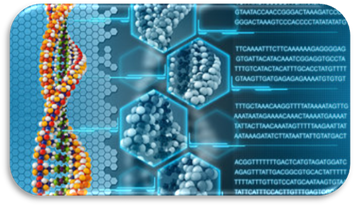
Human
Genome Project
In 1990 the Human
Genome Project began. A genome refers to all of the genetic material
in an organism. The Human Genome Project had the goal of determining the entire
nucleotide sequence of the human genome by identifying each DNA base pair found
in every chromosome. This project was an international effort consisting of
more than 20 laboratories in six countries to sequence the 3.2 billion DNA base
pairs that make up the human genome. Some of the surprising findings include:
·
Humans have only about 25,000 genes when
it was expected that we have around 120,000.
·
Most human DNA is noncoding, or introns.
It appears less than 2% of the human DNA actually codes for proteins.
·
Many of the human genes are identical to
those of other species.
·
All humans are genetically close. The DNA
of any two humans is 99.9% similar.
In 2001 the first draft of the human genome was
released. In 2003, it was announced that the human DNA sequencing was finished.
Knowing the human genome helps researchers diagnose genetic diseases, possibly
treat some genetic diseases, and helps to identify individuals.
Genetic
Engineering
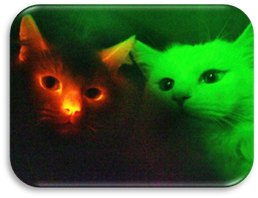 Understanding the human genome now
allows the opportunity to locate genes, copy specific genes, turn genes on or
off, and even move genes between cells. Genetic
Engineering is the alteration of the genetic material of an organism as in
transferring genes from one organism to another. For example, some diabetic
patients need insulin. Because scientists now know the location of the insulin
gene, they were able to remove a normal functioning insulin gene and place it
into a bacterial cell. The genetically engineered bacterial cell will now
produce human insulin, which can be given to some diabetic patients. Before the
production of genetically engineered insulin, which began in 1982, diabetics
had to rely on cow or pig insulin which could create adverse reactions. The
insulin produced by the bacteria through genetic engineering is from an actual
insulin-producing human gene. See the section “Gene Recombination” below for
what this process involves.
Understanding the human genome now
allows the opportunity to locate genes, copy specific genes, turn genes on or
off, and even move genes between cells. Genetic
Engineering is the alteration of the genetic material of an organism as in
transferring genes from one organism to another. For example, some diabetic
patients need insulin. Because scientists now know the location of the insulin
gene, they were able to remove a normal functioning insulin gene and place it
into a bacterial cell. The genetically engineered bacterial cell will now
produce human insulin, which can be given to some diabetic patients. Before the
production of genetically engineered insulin, which began in 1982, diabetics
had to rely on cow or pig insulin which could create adverse reactions. The
insulin produced by the bacteria through genetic engineering is from an actual
insulin-producing human gene. See the section “Gene Recombination” below for
what this process involves.
The DNA that has been manipulated, or recombined, by
way of genetic engineering is called recombinant
DNA. The organisms with recombinant DNA may be called recombinant,
transgenic, or genetically modified, but most often they are referred to as Genetically Modified Organism (GMO).
GMO
Uses
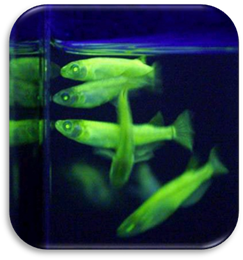
Genetic engineering is involved in almost every part
of our lives, from food to healthcare. This technology, as with other
technologies, has ethical concerns and is highly controversial. We discussed
earlier in this course what ethics involves. As with most technologies, many
people feel genetic engineering may be stepping out of bounds into areas we
shouldn’t enter into, while others feel this is progress which will safely
improve all human lives. GMOs can be found in many different areas. GMOs can be
used as food crops. Most corn and soybean products sold have been
genetically engineered. A gene from Bacillus
thuringiensis (bacteria species) that naturally produces an insecticide has
been added to these crops as a natural insecticide produced now by the plant.
Many other food crops have been engineered to be easier to grow or more
nutritious. GMOs can be used in livestock. Many animals are being
engineered to grow faster with less fat. GMOs are being used in medical
treatment by using bacteria to produce human insulin, as was already
mentioned, and other proteins for humans. GMOs can also be used as research
tools. Using GMOs can help researchers trace a less noticeable gene.
Researchers may place a “glow” gene in an organism that can be used to trace
that organism which actually has a less noticeable gene that they wish to
study.
Gene Recombination
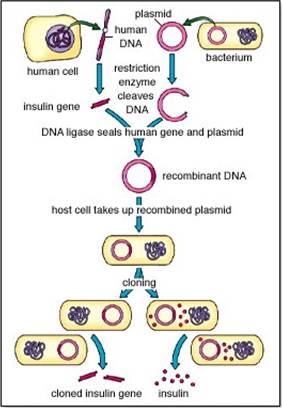 Gene
recombination is the process of inserting a gene of one
organism (ex. human insulin gene) into the DNA of another organism (ex. plasmid
of bacterial cell). The gene that is inserted will be transcribed and
translated as part of the host organism’s DNA, and also replicated easily as
the host organism’s DNA replicates. Gene recombination is completed in the
following steps:
Gene
recombination is the process of inserting a gene of one
organism (ex. human insulin gene) into the DNA of another organism (ex. plasmid
of bacterial cell). The gene that is inserted will be transcribed and
translated as part of the host organism’s DNA, and also replicated easily as
the host organism’s DNA replicates. Gene recombination is completed in the
following steps:
1. Isolate a
gene - The two sets of DNA are cut or opened by the same restriction
enzymes so both fragments of DNA will have the same matching “sticky” ends. One
fragment of DNA is the desired gene (human insulin gene) to be recombined and
utilized. The other DNA (bacterial plasmid) will be used to carry the gene
between cells and is called a vector.
2. Producing
Recombinant DNA - The DNA fragment from the first organism (human insulin
gene – “Donor Gene”) is combined with the host DNA (bacterial plasmid –
“Vector”). DNA ligase is then added
to help bond the sticky ends of the DNA fragments together.
3. Inserting
Recombinant DNA - The recombinant DNA (human insulin gene and bacterial
plasmid vector) is inserted into a bacterial cell (GMO – “host”).
4. Cloning DNA
- Every time the bacterial cell divides, the recombinant DNA now replicates and
divides with each new daughter cell. Each new daughter cell also produces human
insulin.
Polymerase Chain Reaction
Polymerase
Chain Reaction (PCR) is a technique that is used to make many
copies of selected segments of DNA. Adding DNA polymerase, nucleotides, and
primers, and controlling the temperature will produce many copies of a DNA
sample in a relatively short amount of time. This technique involves separating
the two strands of DNA at a high temperature. Next the temperature is lowered
and DNA polymerase will replicate the targeted DNA. Sometimes only a very small
amount of DNA is available. Scientists will use PCR to quickly produce large
amounts of that small DNA sample. Large quantities of copied DNA may be used in
identifying people involved in crime scenes, diagnosing genetic disorders, or
studying ancient DNA fragments.
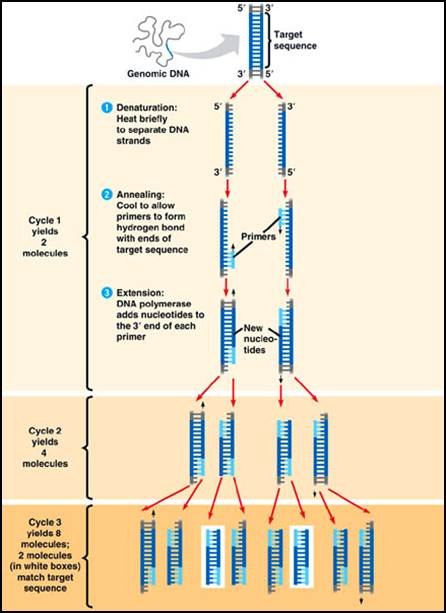
DNA Fingerprinting
DNA
Fingerprinting (Southern Blot Test) uses a technique known
as Gel Electrophoresis which is a
technique used to separate fragments of DNA according to their size and
charge. DNA Fingerprinting is completed in the following steps:
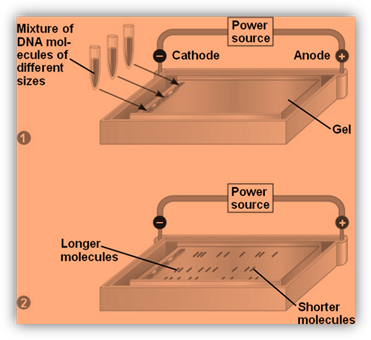
1. DNA fragment samples for comparison are placed in
wells found on one side of the gel.
2. An electric current is passed through the gel from
the negatively charged end where the DNA samples are located to the positively
charged end of the gel. The DNA fragments migrate across the gel, but not at
the same rate. The smaller fragments of DNA travel faster and farther than the
larger fragments.
3. Now the bands of DNA that have been separated need
to be made visible. The separated bands of DNA are blotted onto filter paper.
Probes (radioactive segments of DNA) are added to the filter paper. The probes
make the bands of DNA now visible when exposed to photographic film. The bands
can now be analyzed for identification of samples through comparing the
patterns.
DNA Sequencing
DNA
Sequencing (Using the Sanger Method) is the process of
determining the exact order of every nucleotide in a gene. This
technique uses single-stranded DNA, primers, DNA polymerases, and replication
terminators. The fragments produced by the replication terminators (a
terminator for each nitrogenous base) will then undergo gel electrophoresis
which will separate the fragments into a nucleotide sequence. Each of the four
nitrogenous bases (adenine (A), cytosine (C), guanine (G), thymine (T)) is
represented by a lane in the gel.
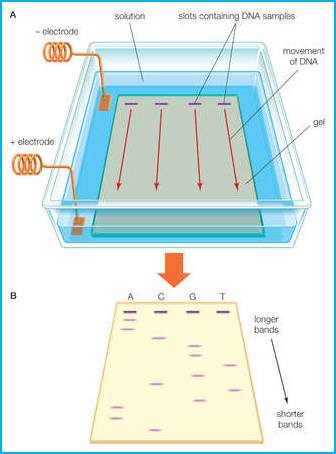
Reading DNA Fingerprinting & DNA
Sequencing
Reading “DNA
fingerprinting” is done simply through comparing multiple bands and
discovering which bands or lanes are most similar to each other. Finding
similarities can help identify individuals or find relationships. [Notice that
Suspect 2 matches the crime scene DNA.]
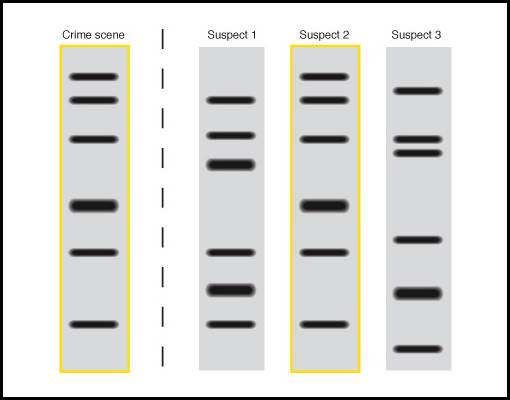
Reading the “DNA
sequence” requires you to start at the top of the gel and read each band,
in order, from top to bottom recording the lane of the band. [Follow the red
line of the figure on the right.]
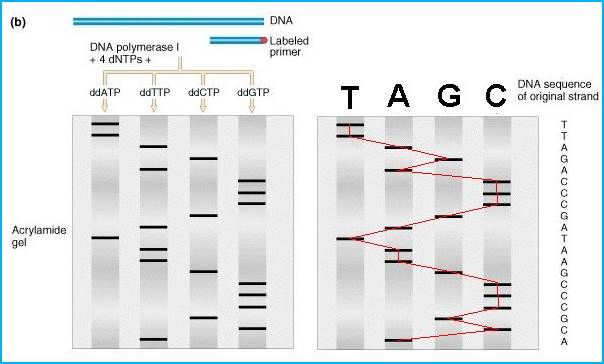
Cloning
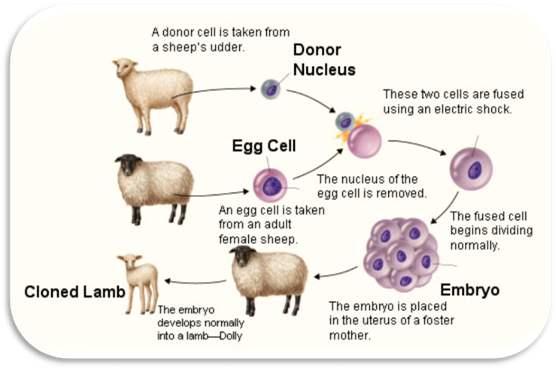
A clone is
an organism, cell, or piece of genetic material that is genetically
identical to one that was pre-existing. The process of making a clone is
naturally accomplished in any organism that reproduces asexually. Remember,
asexual reproduction creates offspring that are genetically identical to the
parent. Producing clones in large animals is a difficult process primarily
because of the developmental process and all the chemicals that act as signals.
A clone made from an adult mammal was born in 1997 and was named Dolly. Dolly
was a cloned sheep. You need to understand that there were 246 failed attempts
before Dolly was born. Sometimes clones do not survive for long, sometimes
fetuses grow beyond normal size, or sometimes clones fail to develop with
normal age. Because of the problems associated with cloning and the ethical
dilemmas it creates, human cloning is illegal in many countries.
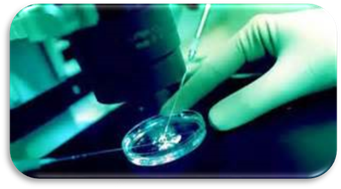
The cloning of Dolly used a process known as Somatic-Cell Nuclear Transfer (SCNT).
This process involves the nucleus of an egg cell being replaced with the
nucleus of an adult somatic cell. Then, the egg cell begins to develop as a
result of some environmental condition or stimulus. Something to know about the
process is that as Dolly grew older, her chromosomes began showing signs of
premature aging, because her chromosomes were the age of the donor.
Interactive Activity
The method by which Dolly the sheep was cloned is presented as well as the ethical considerations of human cloning in the following video.
https://www.dnalc.org/view/16992-Cloning-101.html
Stem Cells
A stem cell
is a cell that can continuously divide and differentiate into specialized
cells. There are three types of stem cells. Totipotent cells can give
rise to any cell or tissue type. Pluripotent cells can give rise to all
types of cells except germ cells. Multipotent cells can give rise to
just a few other cell types. The state of the cell depends on the stage of development
of the body and the tissue of which the cell is part. The cells of new embryos
are totipotent at first and pluripotent during development. The bone marrow
cells of an adult, as well as some other tissue types, are multipotent cells.
The issue with stem cell research is the use of extra human embryos from
fertility clinics. In some cases, the parents who utilize the fertility clinic
will give permission for the scientists to use any extra embryos for research.
Using human embryos for the sole purpose of obtaining the stem cells for use in
another organism has created a strong ethical debate. A newer source of
embryonic stem cells is through SCNT cloning. Some believe this process should
be considered ethically acceptable because the embryo produced does not have
true parents.
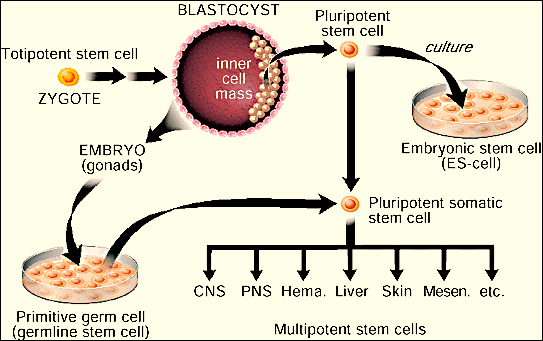
Unit 19 Worksheet Gene
Technologies
UNIT VOCABULARY
REVIEW
Click on the Quizlet icon below to access the quizlet.com vocabulary flash
cards. Review the vocabulary before completing your assessment.
 Now answer questions 1 through 20.
Now answer questions 1 through 20.
